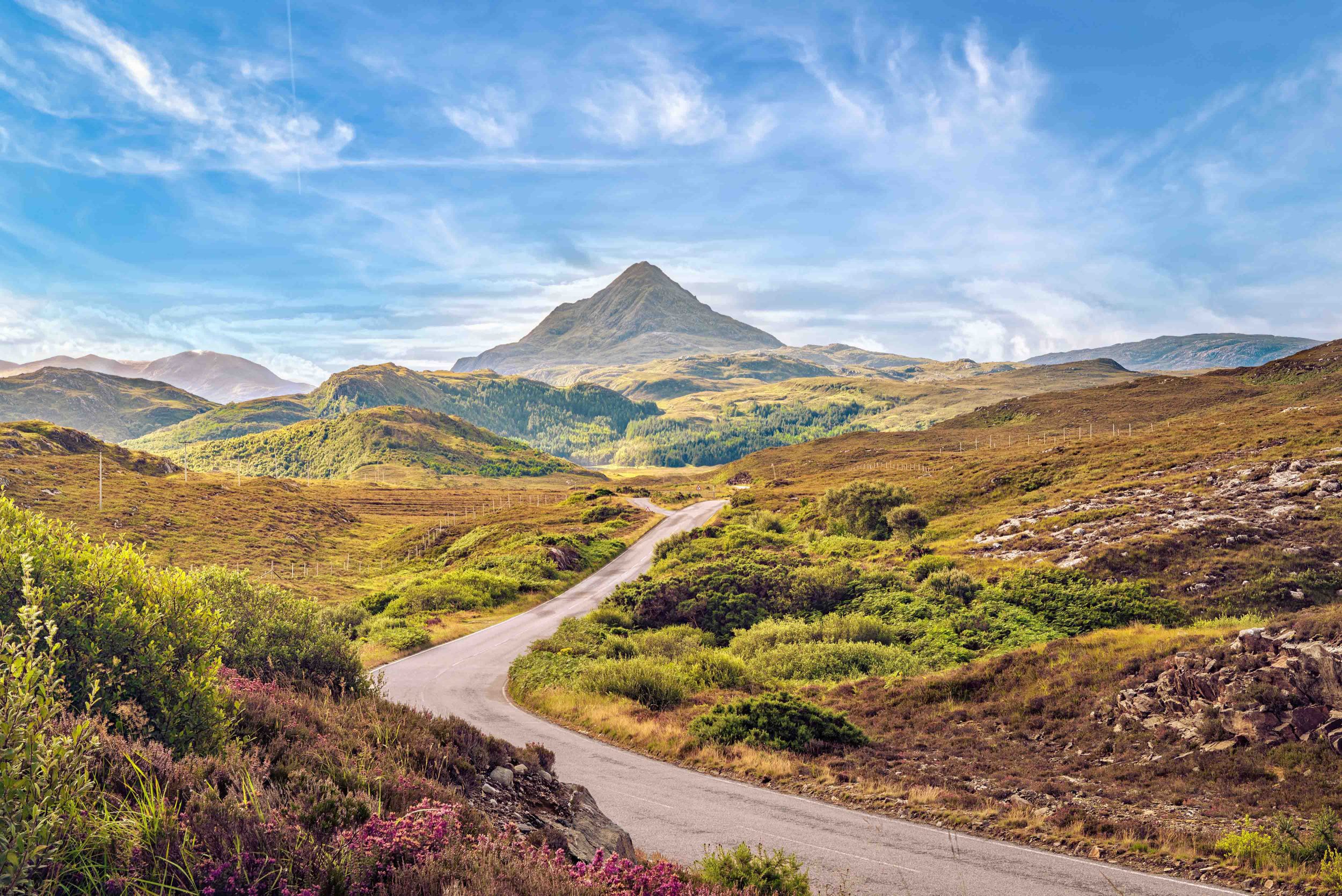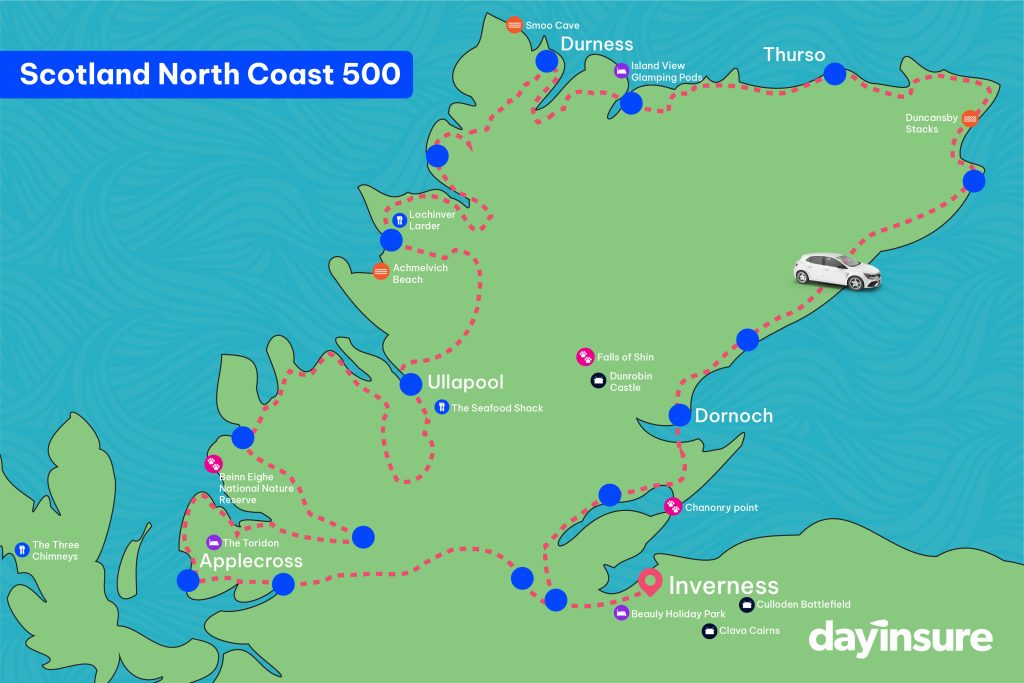The North Coast 500 (NC500) is a popular road trip route in Scotland, spanning 516 miles around some of the most scenic roads the UK has to offer. If you’re looking for a road trip getaway with beautiful coastlines, historic attractions, incredible mountains and delicious local food, Scotland’s North Coast 500 is your answer.
- What is Scotland’s North Coast 500
- Everything you need to create your Scotland North Coast 500 itinerary
- Tips for driving the North Coast 500
- FAQs about the North Coast 500 Scotland
Whether you’re travelling on your own, with family, or with friends, our comprehensive guide covers all the top spots you’ll want to visit to make your North Coast 500 road trip unforgettable.
What is the North Coast 500 in Scotland?
Scotland’s North Coast 500 is a popular road trip route that takes you around the North coast of the Scottish Highlands. Starting and ending in Inverness, it is recommended to allow at least a week to travel the route itself; however, you may need to allocate extra days to travel to and from the start and end point.
The North Coast 500 was officially launched in March 2015 by the Tourism Project Board of the North Highland Initiative and so the route is well marked and sign-posted for drivers.
What sets the North Coast 500 apart from other road trips is its diverse offerings. The route is suitable for all types of travellers, including families, campers, adventure seekers and even those just looking for a scenic getaway. From beautiful beaches and dramatic cliff views to ancient castles and interesting local culture, there’s something for everyone along the route.
Everything you need to create your Scotland North Coast itinerary
There’s so much to see along the North Coast 500 that it’s important you create an itinerary before you go to avoid missing out on anything. To create your Scotland North Coast 500 itinerary, you should take a look at all the key attractions, best eateries and places to stay and create a short-list of what interests you and fits in with your timeline.
We’ve put together a list of our top highlights along the route to help you plan the perfect itinerary for your road trip.
Places to eat
You’ll be spoilt for choice on eateries along your North Coast 500 road trip. Whether you’re looking to push the boat out on a luxurious meal or wanting a quick snack stop to top up before you hit the road again, this route has it all.
Luxury dining:
- Applecross Garden: this Michelin Guide recommended café and restaurant is set within a Victorian walled garden in Applecross. It offers a fantastic selection of delicious food in a relaxing location.
- Captain’s Galley: a globally celebrated seafood restaurant, serving some of the best produce available in the Scottish Highlands and islands. The menu changes with the seasons and can vary frequently so it’s worth checking as close to your visit as possible.
- 1887 Restaurant at The Torridon: this AA Rosette restaurant winner is a must-visit for luxury dining fans. They serve gourmet food created with many ingredients sourced fresh from the Torridon Farm and Kitchen Garden and fresh fish and meat sourced from nearby estates, giving you an authentic taste of the Scottish Highlands.
- The Three Chimneys: this unique dining experience is one of Scotland’s most famous restaurants. Set in an old stone cottage, the restaurant serves tasty dishes created from high quality local ingredients.
Casual dining:
- Lochinver Larder: started in 1986, Lachinver Larder is famous for its delicious pies that have become so popular they can now be bought and posted anywhere in the UK. You’ll be spoilt for choice with over 15 different fillings to choose from including both sweet and savoury.
- The Seafood Shack: claiming to be Ullapool’s best local seafood spot, they offer a range of freshly caught seafood including lobster, prawns, oysters and more. Local fishermen drop off their catch of the day every morning at this location and the menu is created depending on what has been delivered.
- Puldagon Farm: located in the serene Caithness countryside and with roots dating back to 1925, this farm has become a popular destination for both locals and travellers. The restaurant offers a menu that celebrates Scottish cuisine with an added modern twist.
- The Store Bistro & Bar: marketed as ‘friendly, affordable and reliable’, this café is steeped in local history having once been stocked by Gardiners of Orkney. The café has a fantastic choice of food, from cooked breakfasts and slow cooked soups to fresh coffee and delicious cakes.
Places to stay
There are plenty of accommodation options available along the North Coast 500, from hotels to camping sites. With a bit of planning, you’ll be able to book into some spots in incredible locations along your Scotland North Coast 500 route.
Luxury accommodation:
- The Torridon Hotel: home to one of the luxury dining options mentioned in our previous section, The Torridon Hotel is a 5-star hotel offering luxurious rooms and exceptional service. With views of both mountains and the nearby Loch, it is a true escape in a breathtaking location.
- Tulloch Castle Hotel: located near an old harbour town, this 12th century castle enjoys views of the surrounding rolling hills. This hotel is steeped in history, with the Great Hall featuring 250-year-old panelling and authentically restored grand fireplaces.
Mid-range options:
- The Old Salmon Bothy: this shoreline cottage sits against a sandstone outcrop with stunning sea views. It’s the perfect place to soak in the views and wildlife of the Scottish Highlands.
- Island View Glamping Pods: these cosy glamping pods offer spectacular views out on to the islands at the entrance to the Kyle of Tongue. There are lots of coastal walks nearby this location as well as several beaches within walking distance.
Budget-friendly and camping:
- Beauly Holiday Park: newly refurbished and offering beautiful views of the nearby woodland and river, you can book motorhome, campervan, caravanning and tent spots at this location. They also regularly host local musicians and bands to provide entertainment for guests.
- Windhaven camping and B&B: this accommodation holds the title for the most northerly campsite and B&B on the UK mainland. The site overlooks Brough Bay where you can sit and view seals from the viewing point.
Adventure and off-road
The North Coast 500 offers numerous activities for adventure enthusiasts, with many opportunities to stop off on the route.
- Hiking: there are lots of hiking routes available off the North Coast 500, with trails like Stac Pollaidh and Liathach providing challenging hikes with rewarding views.
- Cycling: the NC500 is popular among cyclists seeking an endurance challenge, but there are also opportunities to cycle sections of the route rather than do it in its entirety.
- Water sports: kayaking, paddleboarding, and other water sports are available at various stops along the North Coast 500. You can even experience zip-lining at Golden Eagle Zipline at Ceannabeinne beach near Durness.
- Wildlife tours: boat trips offer chances to spot dolphins, seals, seabirds, and, if you’re really lucky, even orcas!
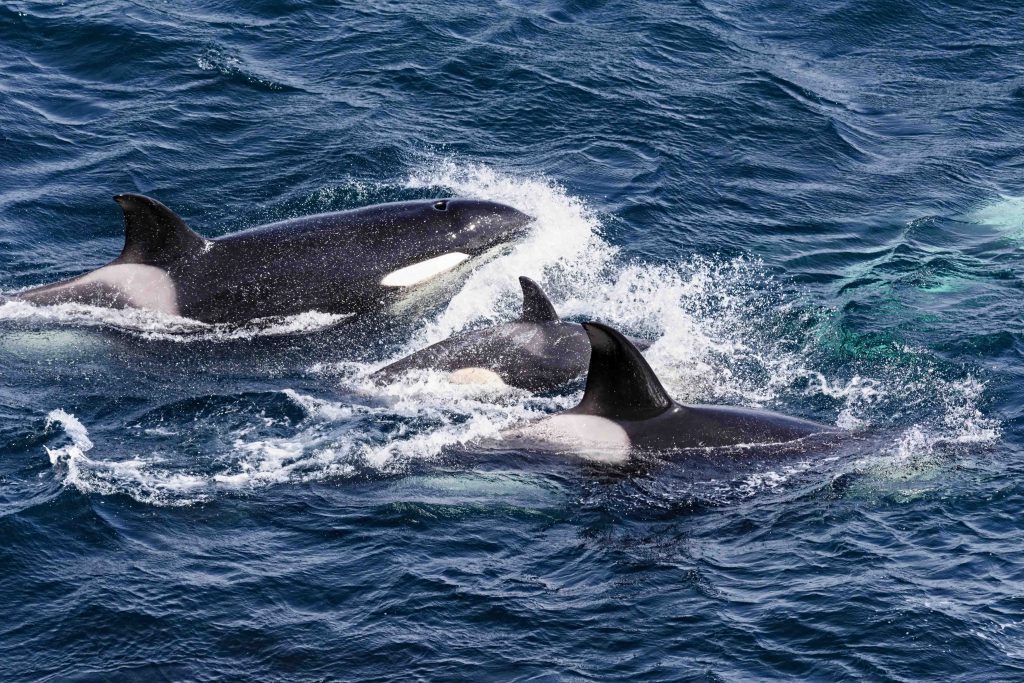
Orcas off Shetland Islands
History and castles
Scotland has a deep and fascinating history, making the North Coast 500 rich with historic stop-offs. From castles to museums and even battlefields, there are several notable sites along the road trip route.
- Dunrobin Castle: this castle is a must-visit. With its fairy-tale like design and 13th century origin, it’s the most northerly of Scotland’s great houses and the largest in the Northern Highlands.
- Culloden Battlefield: the location of the last hand-to-hand battle fought on British soil, this National Trust site and interactive visitor centre is worth a visit to learn more about the Jacobite Rising.
- Highlanders’ Museum: here you can immerse yourself in the largest collection of military artefacts outside of Edinburgh, showcasing the history of the Highland Regiments.
- Clava Cairns: this well-preserved Bronze Age cemetery is a sacred site and was an important place for ritual and burying activities. It is one of the oldest cemeteries in Scotland.
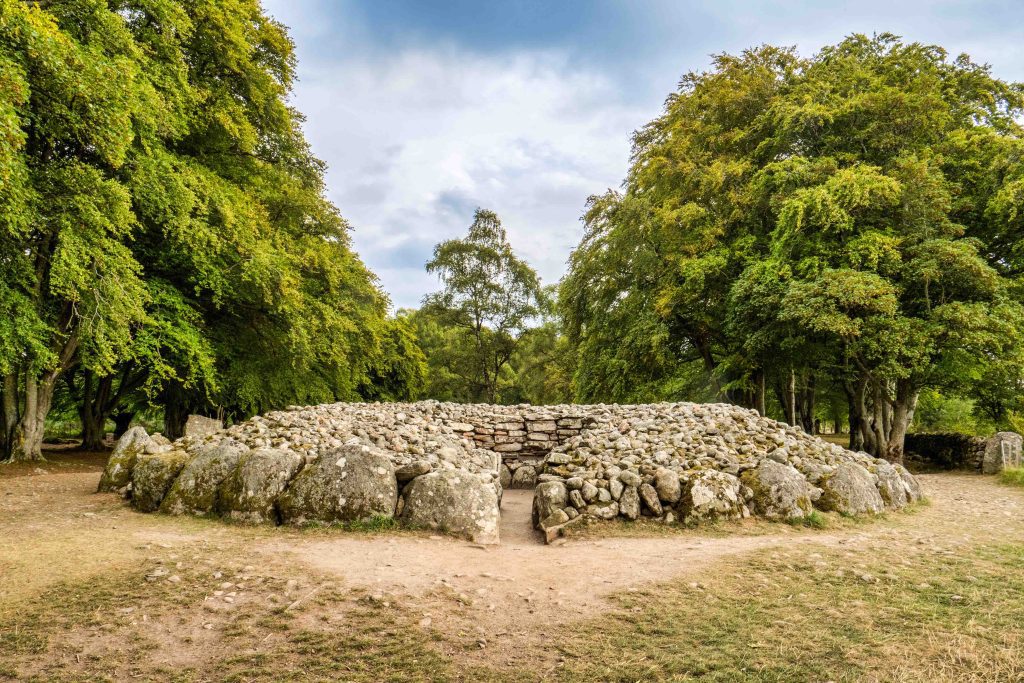
South West Cairn, Clava Cairns, Inverness
Coastal beauty
The North Coast 500 is home to some of Scotland’s most stunning coastal scenery. With dramatic coastlines, picturesque beaches, epic cliffs and pretty seaside towns, there’s plenty to take in along the coastal roads.
- Duncansby Stacks: these impressive sea stacks, with the tallest being around 60 metres tall, are found around a 5 minute drive from John O’Groats. You can also spot a variety of wildlife and seabirds in this area.
- Smoo Cave: this dramatic cave is set into the limestone cliffs in the north-west Highlands. It is both a seawater and freshwater cave, with a large underground waterfall that you can visit by boat.
- Cape Wrath Lighthouse: this lighthouse is located at the most north-westerly tip of mainland Britain. Built in 1828, its stunning, remote location with views of the dramatic cliffs and surrounding coastline make it worth a visit.
- Achmelvich Beach: one of the most popular beaches to visit along the North Coast 500, it’s known for its stunning white sand and crystal clear water. It’s a great spot for swimming, as well kayaking and snorkelling.
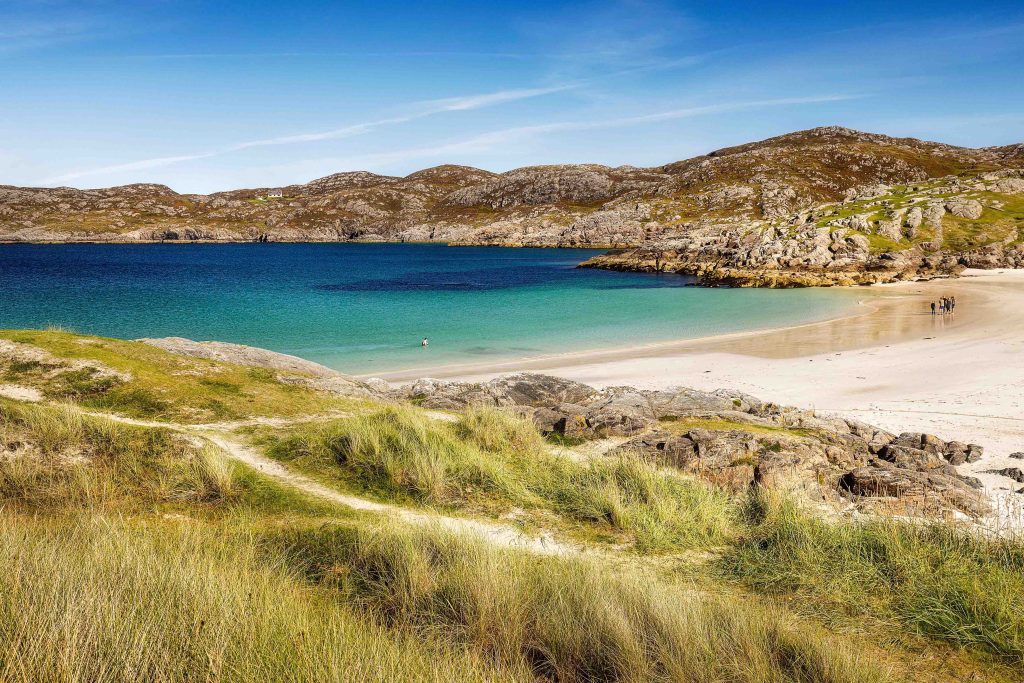
Achmelvich Beach, Sutherland
Towns and villages
All along the North Coast 500 you will find various scenic towns and villages to explore. With hotels, restaurants, shops and refuelling stations, these towns and villages will be key to your North Coast 500 route itinerary.
- Applecross: famous for its spectacular roads, Applecross is located between Loch Kishorn to the south, Loch Torridon to the north and Gled Shieldaig to the east, providing some incredible scenery. There are many places to eat and stay in Applecross, as well as some top sights to visit including Applecross Bay and Applecross Heritage Centre.
- Ullapool: this vibrant fishing village offers a wide selection of things to see and do. It is home to many great food spots, hiking opportunities, boat trips and markets, as well as a ferry terminal which connects the mainland to Stornoway.
- Durness: the most north-westerly village on the Scottish mainland, Durness offers some incredible scenery which can be accessed via its many walking routes and trails.
- Inverness: both the start and end point of the North Coast 500, Inverness is not to be overlooked. It is home to many attractions, including ancient sites, whisky tours and an indoor Victorian market that sells food, clothes and crafts. You can also visit Loch Ness from here and take a tour across the water, whether to view Urquhart Castle or to try to spot Nessie!
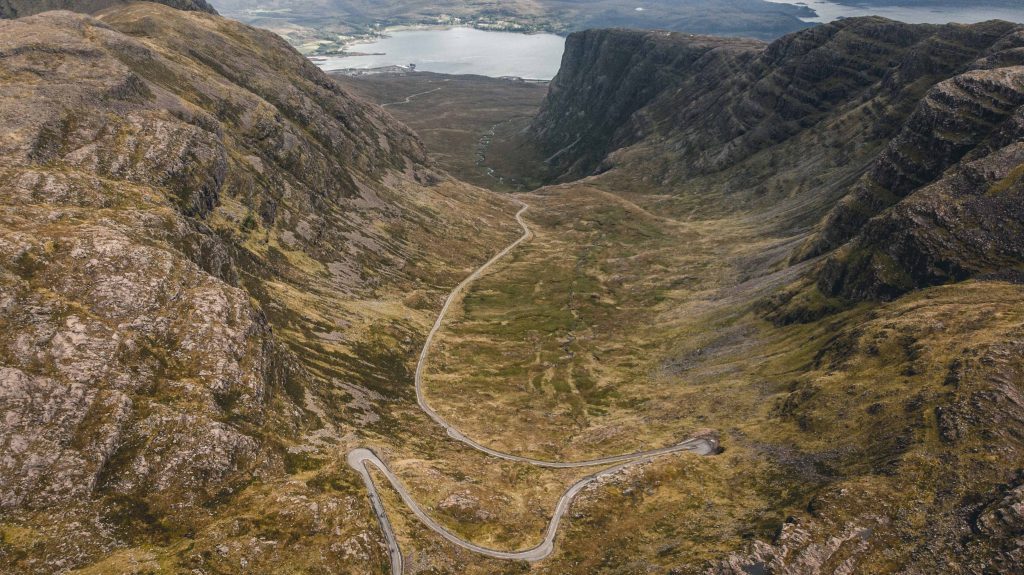
Bealach na Bà
Wildlife and nature
H3: Wildlife and nature
The Scottish Highlands are home to some incredible wildlife and nature. Along the North Coast 500, you can experience some of the very best of it, including waterfalls and nature reserves.
- Handa Island: located off the north-west coast of Sutherland, this small island is a wildlife reserve famous for its seabird inhabitants. It’s home to one of the largest seabird breeding colonies in north-west Europe and is a popular stop for nature lovers to spot puffins.
- Chanonry Point: this narrow peninsula is located between Fortrose and Rosemarkie on the Black Isle, with views across the Moray Firth to Fort George. It is a great spot to spot bottlenose dolphins from the shore. Dolphins are visible from many spots along the North Coast 500, but Chanonry Point provides the best location to view them such a short distance from land.
- The Falls of Shin: this is one of the best and most popular waterfalls to visit along the North Coast 500. It is a great starting point for a range of walking trails that will take you through incredible woodland and along the rocky banks of the Shin. It is also one of the best places in the UK to spot salmon in their natural habitat.
- Beinn Eighe National Nature Reserve: the UK’s very first National Nature Reserve, Beinn Eighe was set up in 1951 and covers around 48 square kilometres. It is famous for its diverse wildlife, with the opportunity to spot golden eagles, pine martens, wildcats and red deer it’s a must-visit!
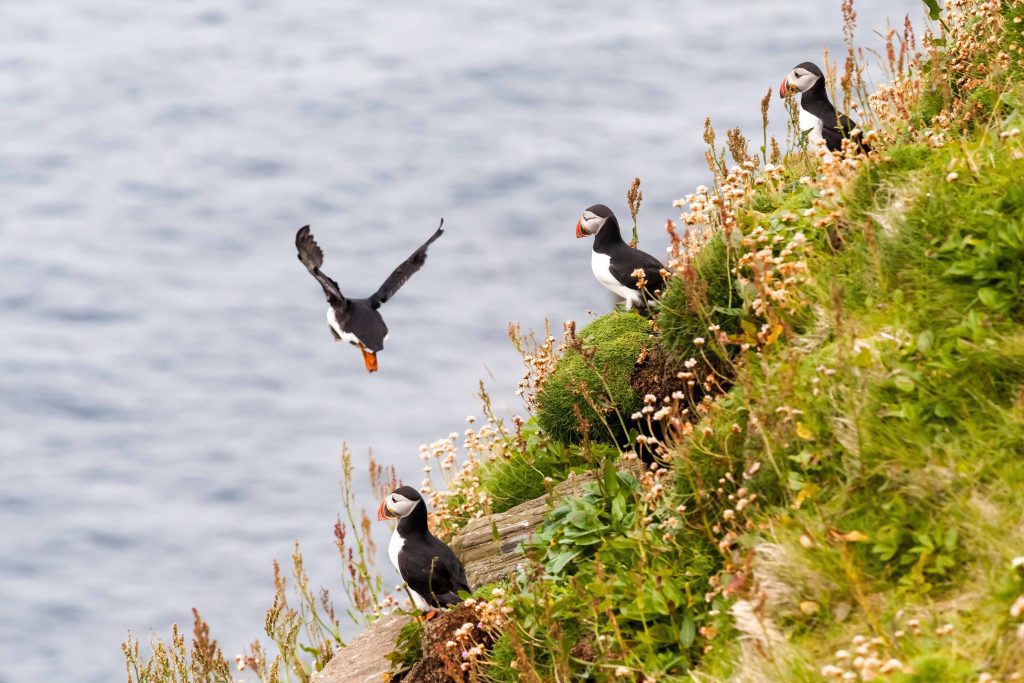
Puffins on Handa Island
Golf courses
Being the ‘Home of Golf’, Scotland has some incredible golf courses, with many located along the North Coast 500. From championship courses to scenic links, there’s something for every level of golfer, and each location comes with its own rich history and stunning views.
- Wick Golf Club: the oldest golf club on the North Coast 500, Wick Golf Club was established in 1870, celebrating its 150th year in 2020. It is a traditional 18-hole links course located at the far north of the Scottish Highlands.
- Royal Dornoch Golf Club: this golf club is home to a world-renowned course with a rich history that can be traced back to 1616. The Championship Course is a fixture on many golf course bucket lists, with holes set against the incredible backdrop of the sandy beach of Dornoch Firth.
- Brora Golf Club: with stunning sea views, this course provides the perfect balance between challenge and fun for golfers of all levels.
- Gairloch Golf Club: if you’re looking for a shorter 9-hole links course Gairloch Golf Club is a great option. With incredible scenery along the course and views over to Skye, it’s rated as one of the world’s best nine hole courses.
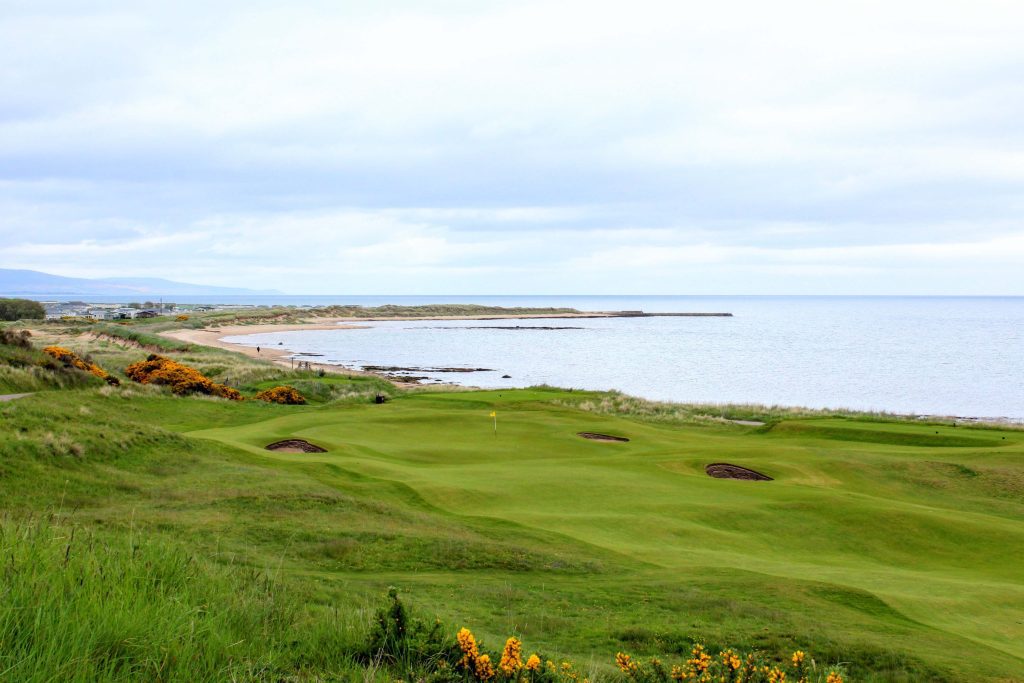
Royal Dornoch Golf Club
Tips for driving the North Coast 500
To help you make the most of your North Coast 500 road trip, we’ve put together some top tips for you to consider when you plan your itinerary and stops along your route map.
We’ve also included some helpful advice from North Coast 500 experts to give you some insider knowledge for your next road trip.
Take your time
“The North Coast 500 is so much more than just a road trip. Each region on the route has so much to offer, from beautiful scenery and fascinating history to welcoming communities and fun activities.” Kathi Kamleitner from the award-winning Scotland travel blog Watch Me See, has lived in Scotland since 2013 and offers practical travel advice for those visiting the country.
“My top tip for the North Coast 500 is to slow down and take your time. Plan to spend at least one week to 10 days on the route (if not more). That way you’ll have time for activities like a hike in the Torridon hills, sea kayaking around the Summer Isles or a day trip to see Puffins on Handa Island. If you have less time, choose a section of the route and explore those regions more in-depth, that way you’ll actually see more and have a more positive impact on the communities you visit.”
As Kathi mentions, we recommend you allocate at least 7 days for the North Coast 500, to avoid having to rush. If you can spend closer to 2 weeks exploring the route, you’ll be able to fully experience everything the North Coast 500 has to offer and safely pack as much into your itinerary as possible.
Plan ahead
“When it comes to touring the northerly coast of the British Isles, the most important thing is preplanning. This includes everything from planning your fuel stops to avoid the more expensive spots, to planning where you are going to buy your food, as well as planning your restaurants, campsites, hotels, and activities all well in advance.” Gemma and Campbell from the travel blog Highlands2Hammocks are two Scots who travel around the UK in their motorhome. They have previously travelled the North Coast 500 and even written an in-depth guidebook detailing the road trip route.
“Other things you can do to make your trip run smoothly involves downloading Google Maps to work offline, as you will struggle for internet at certain points along the route. You should also ensure that you have plenty of water and food with you as you journey so that you do not find yourself stranded without anything.”
The North Coast 500 can be a popular destination in the busier months, so it’s important that you book any accommodation in advance, especially during peak seasons. Natasha, from the travel blog The World Pursuit, has road-tripped the North Coast 500 and said, “after travelling the NC500, we realised how important it is to book ahead.”
“Many of the towns along the route are quiet and small, with just a handful of accommodation options. There are no large hotels in some areas, but rather charming family-run guesthouses. This means that accommodation books up quickly, especially during the summer season. If you miss your chance to book well enough in advance, you may be stuck paying an inflated price, or run the risk of having nowhere to stay!”
Travel during the shoulder months
Driving the North Coast 500 is often better during the shoulder months. These months offer favourable weather with, generally, fewer crowds. There is also the issue of midges when travelling the North Coast 500. These are seen in large numbers during the summer months and can easily make your trip unenjoyable, so it’s good idea to try to plan your trip to miss the midges in their peak numbers.
“If you intend to drive the North Coast 500 during the summer months, then you will be constantly contending with thousands of other campers and cars. Instead, the best time to drive the NC500 is in the shoulder months of Spring (March-May) and Autumn (September-November).” Bradley, from the travel blog Dream Big Travel Far, has driven the NC500 with his partner in their self-built campervan
“If you time your trip correctly, you get to enjoy clear roads, good weather (at least by Scottish standards), and hopefully no midges! We drove the NC500 in October/November and had the most incredible time, seeing hardly any other campers along the entire way. We also had our personal pick of all the best wild camping spots and chance to snap photographs of all the top locations without other people bustling around.”
Pick your direction
With the North Coast 500 being a circular road trip route, with a start and end point both in Inverness, you can travel the route in whichever direction you prefer. You should decide whether to travel clockwise or anti-clockwise based on your interests, whilst also considering accommodation availability.
Most travellers opt to take the route anti-clockwise, meaning you start in Inverness and head up the East coast. This is because the scenery along the West coast is the best along the route and people like to save this for last. However, it can also be a good idea to take the route clockwise and head up the West coast from Inverness as this could avoid heavier traffic with the majority of people opting to take the anti-clockwise route. Whichever direction you take, you will see the same things so you don’t need to be worried about missing out on something should you choose one direction over the other.
Adam from Jack’s Alt-Stays, as seen on BBC Scotland’s Greatest Escape, says “In my opinion, you’ve got to start in Inverness, up the East coast and do the North Coast 500 anti-clockwise. This is purely because the views and landscapes in the West are far more impressive – always leave the best ‘til last!”
Respect the code
With the North Coast 500 being a circular road trip route, with a start and end point both in Inverness, you can travel the route in whichever direction you prefer. You should decide whether to travel clockwise or anti-clockwise based on your interests, whilst also considering accommodation availability.
Most travellers opt to take the route anti-clockwise, meaning you start in Inverness and head up the East coast. This is because the scenery along the West coast is the best along the route and people like to save this for last. However, it can also be a good idea to take the route clockwise and head up the West coast from Inverness as this could avoid heavier traffic with the majority of people opting to take the anti-clockwise route. Whichever direction you take, you will see the same things so you don’t need to be worried about missing out on something should you choose one direction over the other.
Adam from Jack’s Alt-Stays, as seen on BBC Scotland’s Greatest Escape, says “In my opinion, you’ve got to start in Inverness, up the East coast and do the North Coast 500 anti-clockwise. This is purely because the views and landscapes in the West are far more impressive – always leave the best ‘til last!”
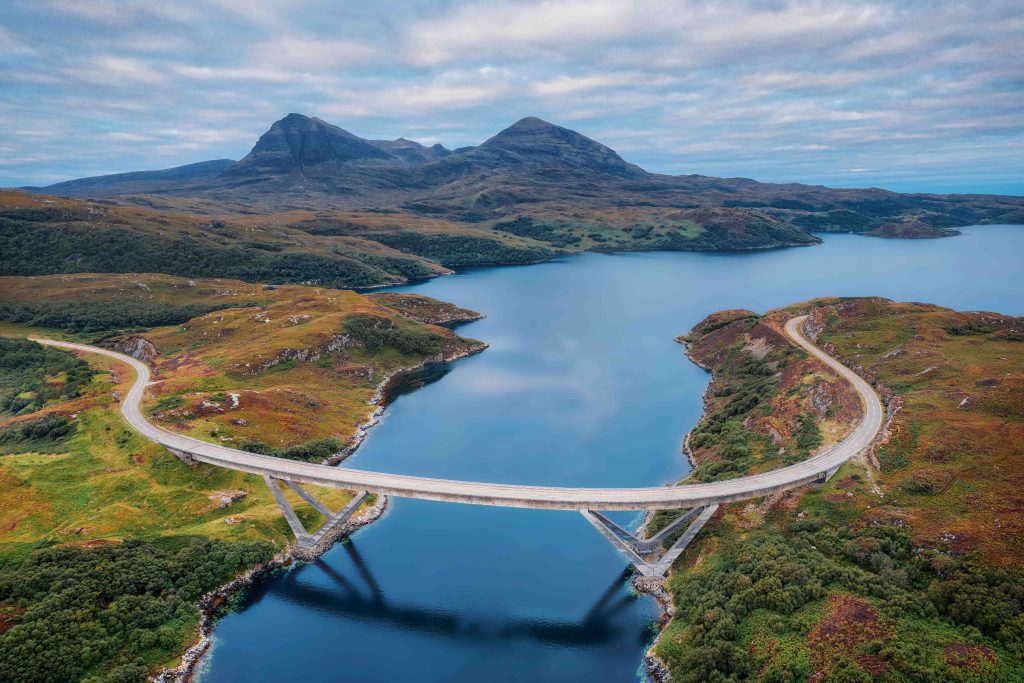
Kylesku Bridge, NC500
FAQs about the North Coast 500 Scotland
Planning a road trip along the North Coast 500 Scotland route can bring up lots of important questions, especially for first-time road-trippers. We’ve covered some of the most frequently asked questions about the NC500, including the Scotland North Coast 500 route map, best seasons to visit, and other top tips to help you have an unforgettable road trip.
How long does the 500 North Coast Scotland take?
With 516 miles of road to cover, the North Coast 500 isn’t a road trip best enjoyed over a weekend. It is recommended to allow at least 5 days for the full journey, with most travellers completing the North Coast 500 in 7 to 10 days. Allowing between 7 to 10 days for the road trip will allow you time to explore various locations at an enjoyable, relaxed pace and appreciate this area of Scotland without feeling like you’re having to rush through.
Are there plenty of petrol stations on Scotland’s North Coast 500?
Whilst there are a number of petrol stations available along the North Coast 500, they can be sparse in the more remote areas of the route. It is advisable to fully refuel when you get the chance and to try to plan your fuel stops before you leave for your trip.
Can I drive the North Coast 500 in an electric car?
It is possible to drive the North Coast 500 in an electric car, with an increasing amount of charging points being added along the route. There are also a number of rapid charge points along the Scotland North Coast 500 which let you recharge and get back to your road trip as soon as possible. As with traditional fuel stations, it is worth planning your charging stops before you leave for your trip.
When is the best time of year to do Scotland’s North Coast 500?
The best times to travel the NC500 are the shoulder seasons of April-May and September-October. These offer a good balance of fewer crowds and decent weather.
The spring and summer months (May-September) are increasingly popular for travelling the North Coast 500 due to the daylight being longer and the (usually) warmer weather; however, these months also come with higher prices, more traffic along the route and increased numbers of midges.
Exploring the North Coast 500 during the winter months (November-March) gives you the potential to see the Northern Lights and the incredible Scottish landscapes covered in snow. The route is quieter during these months; however, it’s worth noting that many attractions will be working on reduced hours and some accommodation spots may not be open. You should also take into account the roads can be much more dangerous in these months, due to the cold, snowy and icy conditions.
Is the North Coast 500 a circular route?
Yes, the North Coast 500 is a circular route, always beginning and ending in Inverness. You can choose to drive it clockwise, or anti-clockwise depending on your preferences. We have detailed the pros and cons of each direction here

Ready to embark on Scotland’s North Coast 500?
The North Coast 500 is an incredible road trip, and the perfect choice for campers, campervanners and hotel-stayers alike. Whether you need to borrow a car or campervan for your journey or want to share the driving with your fellow road trippers, we provide flexible short-term car insurance to make your road trip possible. Get a quote today and use our app to save money on your policy.
